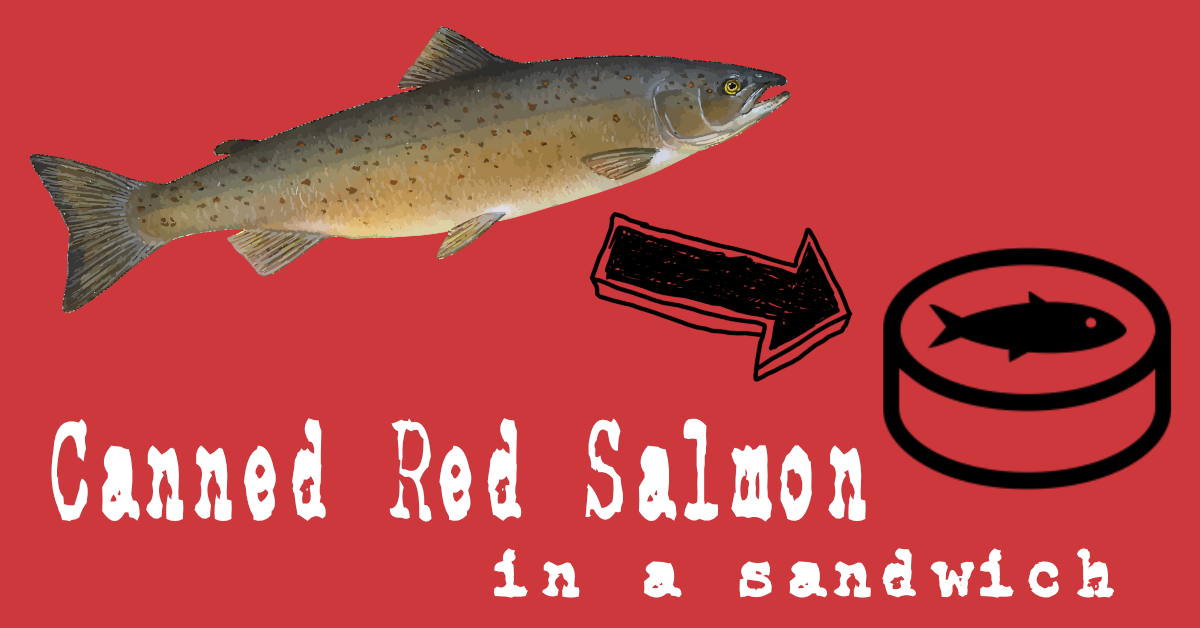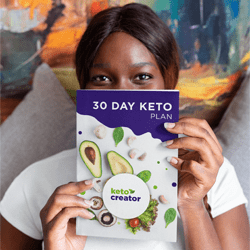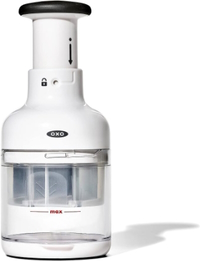Such a simple yet relatively healthy thing to eat on a regular basis yet precious few people enjoy canned red salmon these days, outside of tuna.
While canned tuna is great, I find it surprising that many more don’t appreciate or seek out something as delicious and more Omega 3 packed like canned red salmon, especially the red sockeye variety.
Let’s delve into this guiltless pleasure of red sockeye salmon, shall we?
Red Salmon vs Pink Salmon
Well, pink salmon is more common than red, and a bit cheaper. It’s very beneficial and healthy, so it’s still a good choice if you can’t get red.
Red salmon contains more of the beneficial Omega 3 fatty acids found in fish oil and the deeper red color of the flesh is a result of them feeding on krill, which is actually colored by the krill feeding on astaxanthin rich algae. Astaxanthin is a potent antioxidant and there is more of it in red salmon than in pink salmon.
Canned red salmon is more expensive than the pink so that may be a consideration for some consumers. I’m willing to pay a bit more for the richer taste and I just love the deeper color of the red salmon over the pink salmon.
One thing that many people dislike in canned salmon is the presence of some skin and bones. They are used to how tuna is canned. Canned tuna contains only the meat, not skin or bones. Seeing skin and bones can be offputting to some people.
It’s time to toughen up!
The skin contains much of the beneficial fat, and the bones contain a lot of calcium. They are decalcified, so you can’t choke on them. The bones are brittle and crush with very little pressure, so you can empty the red canned salmon into a bowl and crush it all up with a fork or spoon until it is the desired uniform consistency for your taste. There will be no more visible bones or skin after you do this.
The bones are so brittle that they crush just by a touch. You can’t get poked or choke on them! This is added calcium for you!
The Canned Red Salmon Sandwich
The way I prefer to consume my canned red salmon is by simply getting some sliced bread and toasting it and then buttering it. You can use white bread, but I prefer sliced Italian bread for it’s stronger and tastier qualities.
I simply fork the red salmon onto the toast and pack it together with a fork, then close the sandwich with the second piece of toasted buttered toast.
You can add lettuce, tomato, onion, or whatever you like, but I like mine simple with just the salmon between the buttered sliced Italian bread toast pieces.
Why do I keep saying toast rather than bread?
Toast is yummier AND it stands up better to the moist salmon.
I prefer Irish butter for the more nutritious darker yellow color, but any butter will work.
Red Salmon Nutrition
One can of Rubenstein’s Red Salmon is 7.5 oz (213g)
Rubenstein’s claims that their canned red salmon is from fresh, top quality fish caught in the clear, cold waters of Alaska. Red (Sockeye) salmon are the species richest in flavor.
-
Vitamin DA natural source of vitamin D, which helps maintain strong bones, boosts the immune system, and reduces the risk of certain diseases
-
Vitamin B12Necessary for the nervous system’s proper functioning and the creation of red blood cells
-
Niacin (vitamin B3)Vital for turning nutrients into energy and treating high cholesterol levels
-
Vitamin AImportant for maintaining retinal health
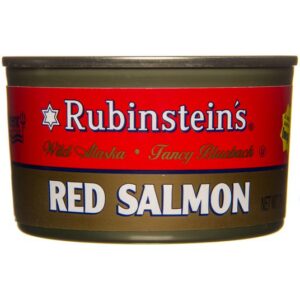
According to Trident Seafoods, a 7.5 oz serving of Rubinstein’s Red (Sockeye) Salmon contains 179 mg of calcium and 263 mg of potassium. It also contains 29 mcg of vitamin D, but no iron or potassium.
Obviously, the nutrition for the same amount would be pretty much the same no matter which brand that you buy. The key here is that this is Red, or Sockeye, salmon. This isn’t the lighter pink salmon that many people are more familiar with. The red is tastier, richer, and contains more antioxidants and nutrients.
Rubinstein’s canned red salmon is a natural source of omega-3 fatty acids, with 1,000 mg per 14.75 oz serving.
Red Salmon , or sockeye salmon, as mentioned near the top of this article, contains astaxanthin, a red-orange pigment and antioxidant that gives salmon its vivid color. Sockeye salmon is a rich source of astaxanthin.
Here are two of those vertical nutrition labels with varying quantities to add to your data.
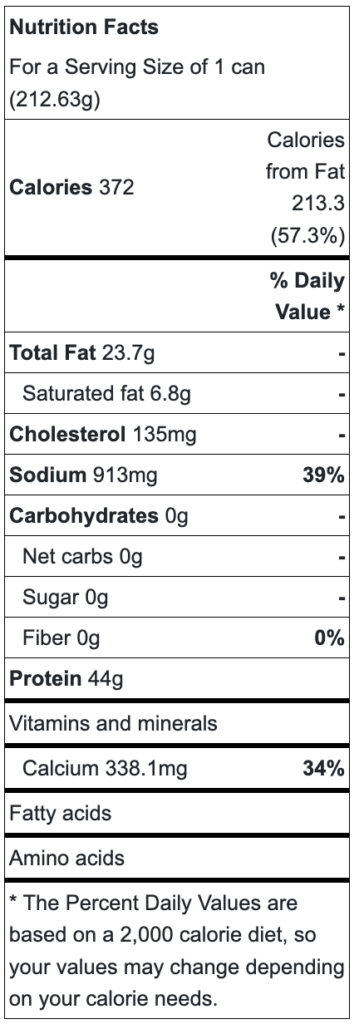
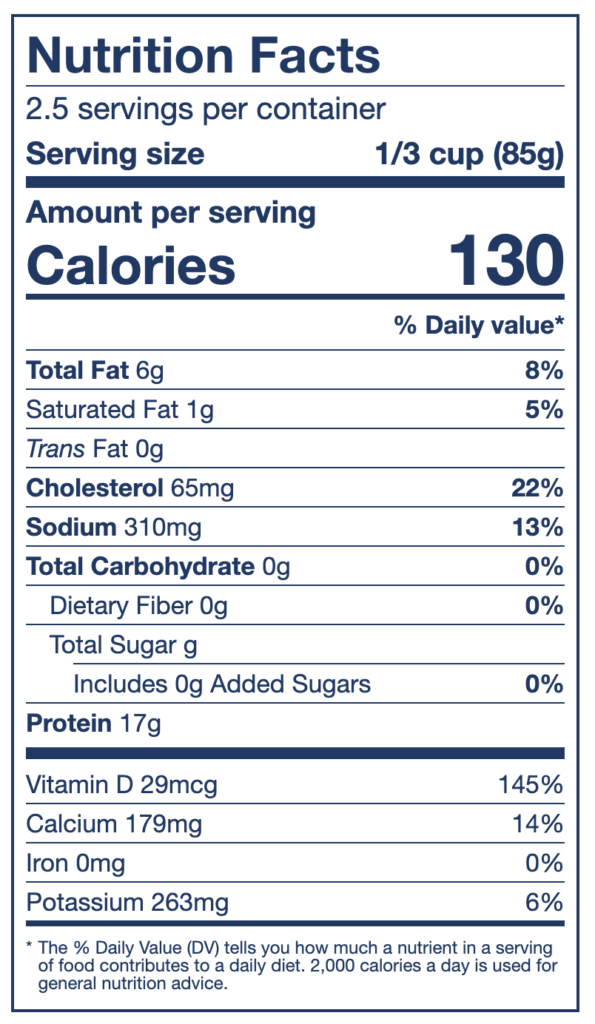
If blood pressure or hypertension is a thing with you, just be aware that canned red salmon is a natural product that contains only red salmon and salt. It contains no artificial colors or preservatives. Canned red salmon can contain high levels of sodium, especially if it’s packed in salt water. The FDA recommends draining canned salmon before eating it, as a can can contain more than 400 mg of sodium, which is about 17% of the recommended daily intake.
The good news is that a lot of that is in the water that it’s packed with so if you dump the water (and who doesn’t?) then much of that goes down the drain.
How is the Best Canned Red Salmon Eaten?
As I stated above, I am totally addicted to Rubenstein’s Red Salmon in a sandwich of buttered toasted wide sliced Italian bread, but you can enjoy this on crackers or in a salad. I personally don’t cook wioth canned fish, but you can casserole it too.
You can mix it with several ingredients and turn it into a salmon burger, but that can be a crumbly mess if you aren’t careful.
You can mix it with mayo ala tuna style if buttered toast isn’t your thing.
If you’re in a jam and don’t have smoked salmon available, you “can” blend this with cream cheese and a dash of liquid smoke, but on second thought you might want to get the skinless and boneless pink kind for that.
If you’re in a jam you can even fork it right out of the can!
Looney Foodie hopes that this has broadened your culinary and pescatarian horizons to include canned red salmon into your repertoire.

